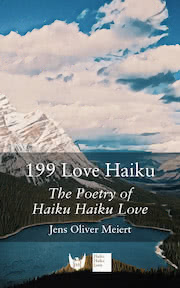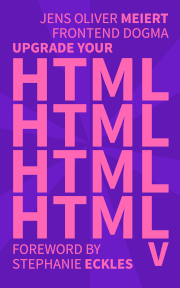Design
Website Optimization Measures, Part XXV
On caching headers, capitalization, social graphics, download priorities, logical properties, Cloudflare, viewport metadata, obsolete markup, and calls to action.
On Title Case
Casual thoughts about my experience with title case, a recent switch from AP-inspired to NYT-governed guidelines, and the respective guidelines themselves.
Website Optimization Measures, Part XXIV
On AVIF tests, book prices, AI experiments, Eleventy performance, IE scripts and styles, domain registrations, site headers, and (old) document functionality that can better be handled by native HTML elements than by handmade scripts.
Website Optimization Measures, Part XXIII
Affiliate marketing and ads and Brave Rewards. HTML elements and dotenv and Git. Spellings and designs and stuff.
Website Optimization Measures, Part XXII
Web design is a process, running our own websites is awesome, and together it means there’s always something to tweak and improve and optimize. Select things I’ve done over the last few months.
Website Optimization Measures, Part XXI
Who hasn’t had enough of style sheet reviews, editor performance optimizations, ad removals, CTA revisions, pseudo-class refactorings, blocked AI crawlers, custom search engines, social graphics, or server log configs.
WebGlossary.info
The Web Development Glossary—now also available as a website. Enjoy exploring.
Website Optimization Measures, Part XIX
Dull maintenance drudgery (?), this time covering dependencies, link checks, keyboard navigation, contrast, hidden UI elements, multi-language tag handling, image compression, IndieAuth, and AI crawling.
200 Web-Based, Must-Try Web Design and Development Tools
A couple of web-based and free tools to test and improve accessibility, performance, security, conformance, colors and images and typography, SEO and SEM and—more. With an opinion about link lists, and appreciation for well-maintained tool collections.
Challenge Yourself, Even When It’s Art
The paradox of CSS art may suggest an artist had a free pass for the quality of their code. Or does it? I believe there are three possible answers to this.
Website Optimization Measures, Part XIV
About link relationships, Twitterbot, dark mode, tags, addresses, social markup, color-scheme, and—FLoC.
The CSS Art Paradox
The fanciest CSS, standing on the shoulders of bloated HTML.
33 Additional Web Development Terms You May Not Have Heard Of
As you know, Web Development has its own, special vocabulary that easily consists of several thousand terms. Do you like to try your knowledge again, on how many of the following 33 terms you know?
Website Optimization Measures, Part XI
Welcome to another round-up of possible website improvements, this time going from several types of link updates to table of contents CSS upgrades to CDN integration and privacy policy checks.
33 Web Development Terms You May Not Have Heard Of
Web Development has its own, special vocabulary that easily consists of several thousand terms. Even if you’re an experienced developer you’re unlikely to know all of them. Still, do you like to try your knowledge? How many of the following terms do you know?
The 4 Pillars of Good Embed Code
Embed code is third-party code to be integrated on websites and apps, like ads or social media widgets. There have been many problems with embed code for a very long time. This post covers the essence of what makes for good embed code.
How Running Your Own Website Is Much Better for You Than You Think
The typical reason for why professionals don’t have their own websites is that they don’t want to make the commitment, and yet that misses how the disadvantages people see are actually advantages. Renewed thoughts on how running your own website is an asset.
When to Open Links in a New Tab
Always open links in the same tab unless doing so 1) could disrupt a process, 2) could risk data loss, or 3) could confuse the user.
The Developer’s Fallacy of Close Collaboration With Designers
Working closely with designers makes sense and is awesome, notably for mutual understanding and efficiency. And yet there are also good reasons not to work closely with designers. For developers it’s important, for otherwise foolish, to be aware.

199 Love Haiku (the Book)
In 2016, I wrote 1,000 short poems, haiku-style. I wrote those poems to challenge myself as a writer. I launched a website for the haiku and I shared the story. Today, I’ve published the 199 haiku that a few friends and I liked the most as a book.
Print Styling, the 3 Basics
Many sites are not prepared for print, and yet our users print, and they save through print. Therefore: Have a print style sheet, and be it a negative one. Hide what’s not usable or useful. Always test, and tweak when you want better.
What Happened on Google+, the Web Development Archives
Following a few philosophy posts to be archived, here are past entries related to web development. Nothing more, nothing less.
Should Designers Code
Arguments for a “no” to a recurring question: Why we may want to give designers all freedom in the world, not to be limited in what they’re trained to do best.
Highlights From “Flatland” (Edwin Abbott Abbott)
“Yet I exist in the hope that these memoirs, in some manner, I know not how, may find their way to the minds of humanity in Some Dimension, and may stir up a race of rebels who shall refuse to be confined to limited Dimensionality.”
Highlights From “The Elements of Style” (William Strunk Jr.)
“Consciously or unconsciously, the reader is dissatisfied with being told only what is not; he wishes to be told what is.”
Categories
- Adventure (29)
- Design (67)
- Development (365)
- Everything Else (146)
- Management (26)
- Philosophy (67)
Archives
By Year
By Month
- Oct 2024 (7)
- Sep 2024 (10)
- Aug 2024 (10)
- Jul 2024 (4)
- Jun 2024 (6)
- May 2024 (6)
- Apr 2024 (2)
- Mar 2024 (6)
- Feb 2024 (4)
- Jan 2024 (5)
- Dec 2023 (4)
- Nov 2023 (5)
- Oct 2023 (5)
- Sep 2023 (5)
- Aug 2023 (3)
- Jul 2023 (4)
- Jun 2023 (3)
- May 2023 (3)
- Apr 2023 (4)
- Mar 2023 (2)
- Feb 2023 (4)
- Jan 2023 (2)
- Dec 2022 (4)
- Nov 2022 (5)
- Oct 2022 (5)
- Sep 2022 (3)
- Aug 2022 (2)
- Jul 2022 (2)
- Jun 2022 (2)
- May 2022 (4)
- Apr 2022 (5)
- Mar 2022 (3)
- Feb 2022 (1)
- Jan 2022 (3)
- Dec 2021 (2)
- Nov 2021 (2)
- Oct 2021 (2)
- Sep 2021 (4)
- Aug 2021 (2)
- Jul 2021 (3)
- Jun 2021 (4)
- May 2021 (6)
- Mar 2021 (2)
- Feb 2021 (2)
- Jan 2021 (4)
- Dec 2020 (3)
- Nov 2020 (2)
- Oct 2020 (2)
- Sep 2020 (2)
- Aug 2020 (2)
- Jul 2020 (1)
- Jun 2020 (2)
- May 2020 (2)
- Apr 2020 (3)
- Mar 2020 (2)
- Feb 2020 (2)
- Jan 2020 (4)
- Dec 2019 (5)
- Nov 2019 (3)
- Oct 2019 (2)
- Sep 2019 (2)
- Aug 2019 (2)
- Jul 2019 (2)
- Jun 2019 (2)
- May 2019 (3)
- Apr 2019 (4)
- Mar 2019 (4)
- Jan 2019 (2)
- Dec 2018 (3)
- Nov 2018 (3)
- Oct 2018 (3)
- Sep 2018 (1)
- Aug 2018 (2)
- Jul 2018 (1)
- Jun 2018 (2)
- May 2018 (1)
- Apr 2018 (1)
- Mar 2018 (1)
- Feb 2018 (3)
- Jan 2018 (6)
- Dec 2017 (6)
- Nov 2017 (4)
- Oct 2017 (6)
- Sep 2017 (7)
- Aug 2017 (8)
- Jul 2017 (4)
- Jun 2017 (7)
- May 2017 (2)
- Apr 2017 (3)
- Mar 2017 (3)
- Feb 2017 (5)
- Jan 2017 (6)
- Dec 2016 (3)
- Nov 2016 (6)
- Oct 2016 (1)
- Sep 2016 (2)
- Aug 2016 (5)
- Jul 2016 (6)
- Jun 2016 (3)
- May 2016 (1)
- Apr 2016 (2)
- Mar 2016 (2)
- Feb 2016 (2)
- Jan 2016 (4)
- Dec 2015 (1)
- Nov 2015 (4)
- Oct 2015 (4)
- Sep 2015 (5)
- Aug 2015 (6)
- Jul 2015 (2)
- Jun 2015 (2)
- May 2015 (4)
- Apr 2015 (4)
- Mar 2015 (8)
- Feb 2015 (3)
- Jan 2015 (5)
- Dec 2014 (7)
- Nov 2014 (1)
- Oct 2014 (3)
- Sep 2014 (6)
- Aug 2014 (2)
- Jul 2014 (5)
- Jun 2014 (1)
- Apr 2014 (3)
- Mar 2014 (1)
- Feb 2014 (4)
- Jan 2014 (2)
- Dec 2013 (6)
- Nov 2013 (1)
- Oct 2013 (4)
- Sep 2013 (2)
- Aug 2013 (5)
- Jul 2013 (1)
- Jan 2013 (1)
- Dec 2012 (2)
- Nov 2012 (1)
- Apr 2012 (1)
- Feb 2012 (1)
- Jan 2012 (2)
- Dec 2011 (1)
- Oct 2011 (1)
- Jun 2011 (2)
- May 2011 (2)
- Apr 2011 (1)
- Feb 2011 (1)
- Dec 2010 (3)
- Oct 2010 (1)
- Sep 2010 (1)
- Jul 2010 (1)
- Jun 2010 (1)
- May 2010 (1)
- Mar 2010 (1)
- Feb 2010 (2)
- Jan 2010 (1)
- Dec 2009 (1)
- Nov 2009 (2)
- Oct 2009 (4)
- Sep 2009 (2)
- Aug 2009 (2)
- Jul 2009 (3)
- Jun 2009 (4)
- May 2009 (2)
- Apr 2009 (2)
- Mar 2009 (6)
- Feb 2009 (3)
- Jan 2009 (3)
- Dec 2008 (4)
- Nov 2008 (6)
- Oct 2008 (7)
- Sep 2008 (3)
- Aug 2008 (4)
- Jul 2008 (4)
- Jun 2008 (5)
- May 2008 (5)
- Apr 2008 (2)
- Mar 2008 (6)
- Feb 2008 (5)
- Nov 2007 (3)
- Oct 2007 (1)
- Sep 2007 (4)
- Aug 2007 (2)
- Jul 2007 (2)
- Jun 2007 (6)
- May 2007 (4)
- Apr 2007 (3)
- Mar 2007 (6)
- Feb 2007 (5)
- Jan 2007 (6)

Friend of optimized HTML? Try Upgrade Your HTML (2019–2024). Good HTML isn’t easy. Minimal HTML is underrated. Production HTML can often be improved. This series does so. Available at Amazon, Apple Books, Kobo, Google Play Books, and Leanpub.

Get a good look at web development? Try WebGlossary.info—and The Web Development Glossary 3K. With explanations and definitions for thousands of terms of web development, web design, and related fields, building on Wikipedia as well as MDN Web Docs. Available at Apple Books, Kobo, Google Play Books, and Leanpub.
